Professional Development Portfolio for Business Management Students
VerifiedAdded on 2023/06/09
|11
|3955
|450
AI Summary
This portfolio provides evidence related to professional development for Business Management students. It covers areas such as goal setting, creativity, learning preferences, teamwork, and reflective practice. The portfolio includes the application of appropriate frameworks and models such as VARK model and CREAM strategy. In addition to this, two reflective models are explained which support academic and personal development and their role in improving learning.
Contribute Materials
Your contribution can guide someone’s learning journey. Share your
documents today.
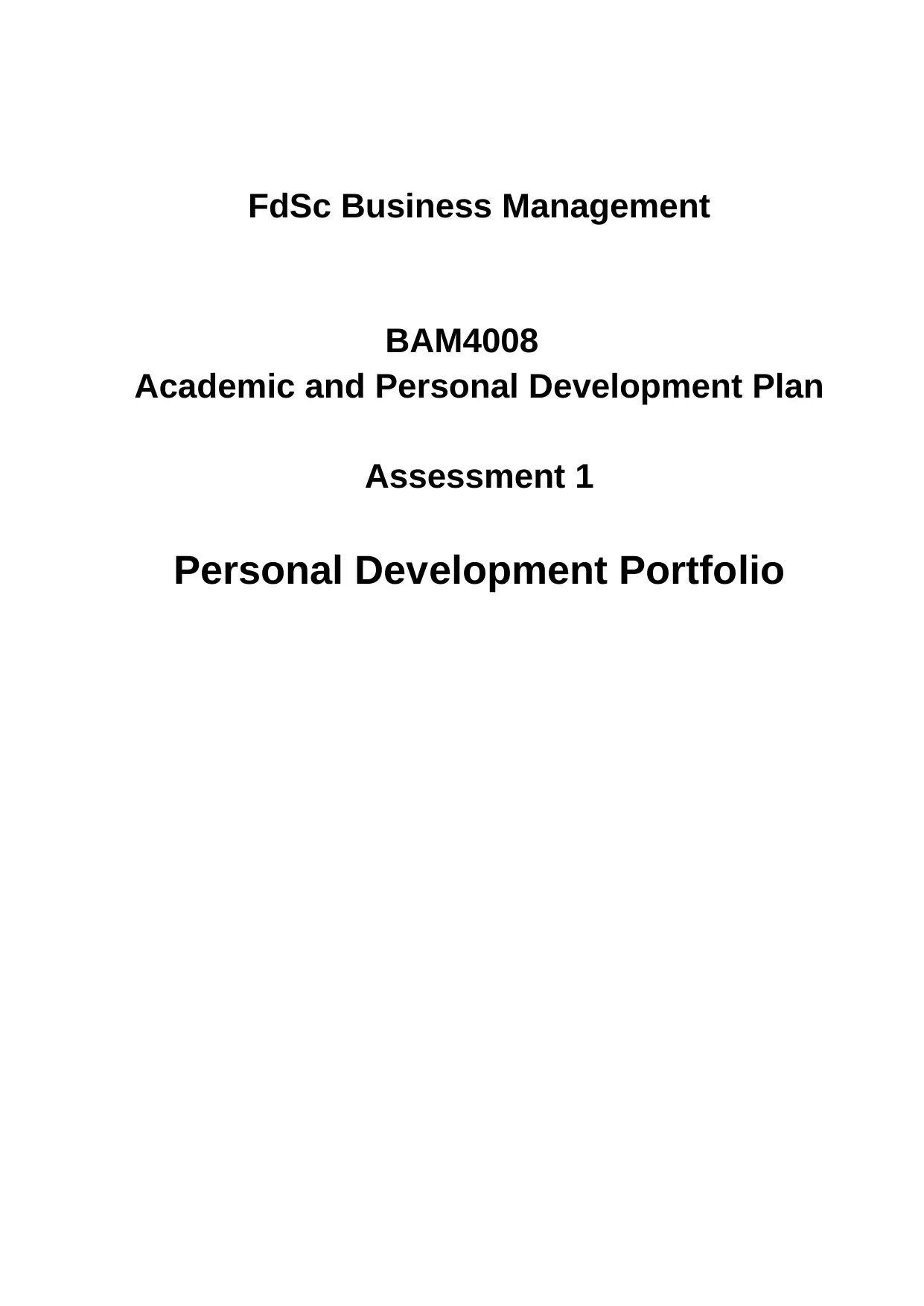
FdSc Business Management
BAM4008
Academic and Personal Development Plan
Assessment 1
Personal Development Portfolio
BAM4008
Academic and Personal Development Plan
Assessment 1
Personal Development Portfolio
Secure Best Marks with AI Grader
Need help grading? Try our AI Grader for instant feedback on your assignments.
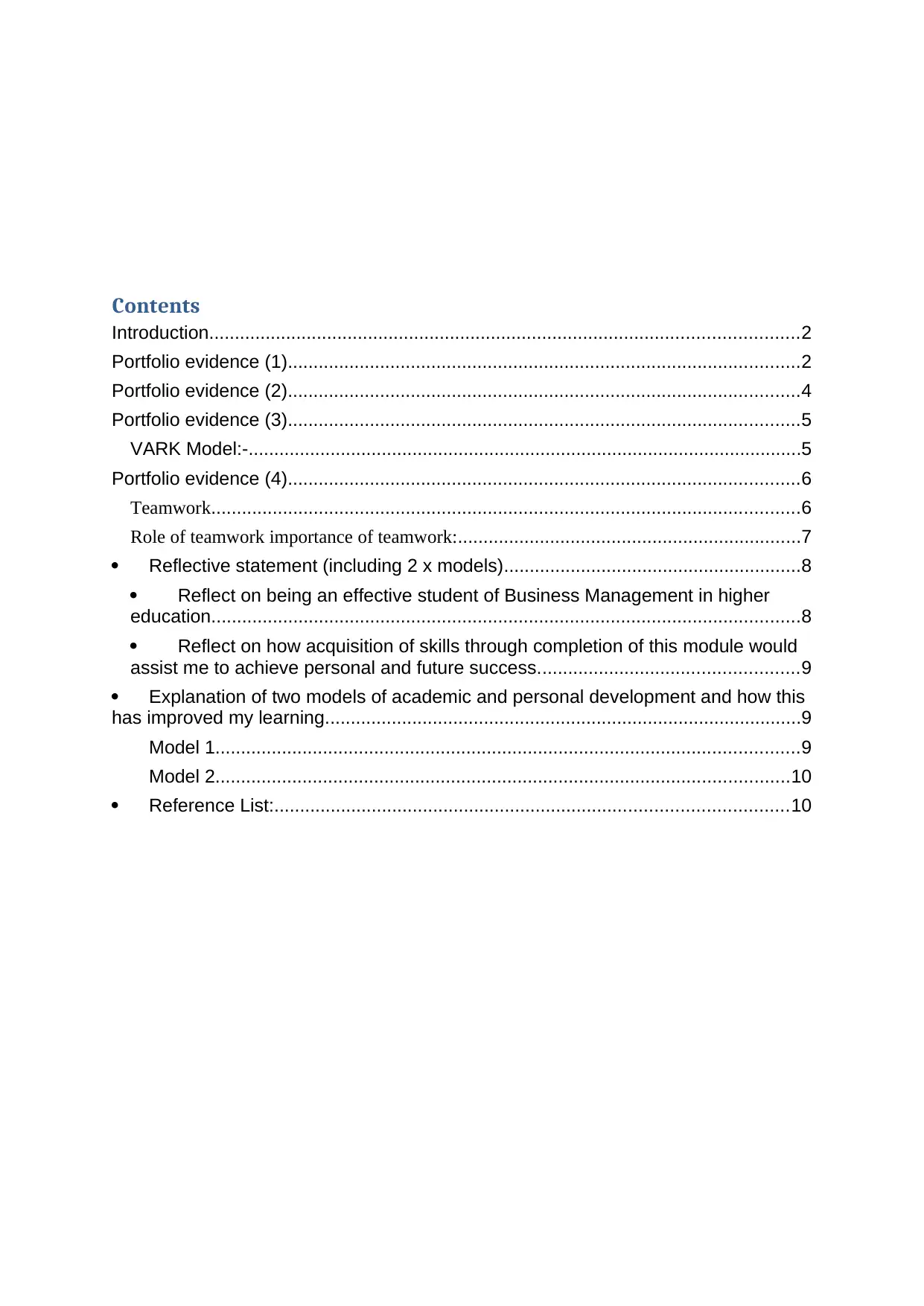
Contents
Introduction...................................................................................................................2
Portfolio evidence (1)....................................................................................................2
Portfolio evidence (2)....................................................................................................4
Portfolio evidence (3)....................................................................................................5
VARK Model:-............................................................................................................5
Portfolio evidence (4)....................................................................................................6
Teamwork...................................................................................................................6
Role of teamwork importance of teamwork:...................................................................7
Reflective statement (including 2 x models)..........................................................8
Reflect on being an effective student of Business Management in higher
education...................................................................................................................8
Reflect on how acquisition of skills through completion of this module would
assist me to achieve personal and future success...................................................9
Explanation of two models of academic and personal development and how this
has improved my learning.............................................................................................9
Model 1..................................................................................................................9
Model 2................................................................................................................10
Reference List:....................................................................................................10
Introduction...................................................................................................................2
Portfolio evidence (1)....................................................................................................2
Portfolio evidence (2)....................................................................................................4
Portfolio evidence (3)....................................................................................................5
VARK Model:-............................................................................................................5
Portfolio evidence (4)....................................................................................................6
Teamwork...................................................................................................................6
Role of teamwork importance of teamwork:...................................................................7
Reflective statement (including 2 x models)..........................................................8
Reflect on being an effective student of Business Management in higher
education...................................................................................................................8
Reflect on how acquisition of skills through completion of this module would
assist me to achieve personal and future success...................................................9
Explanation of two models of academic and personal development and how this
has improved my learning.............................................................................................9
Model 1..................................................................................................................9
Model 2................................................................................................................10
Reference List:....................................................................................................10
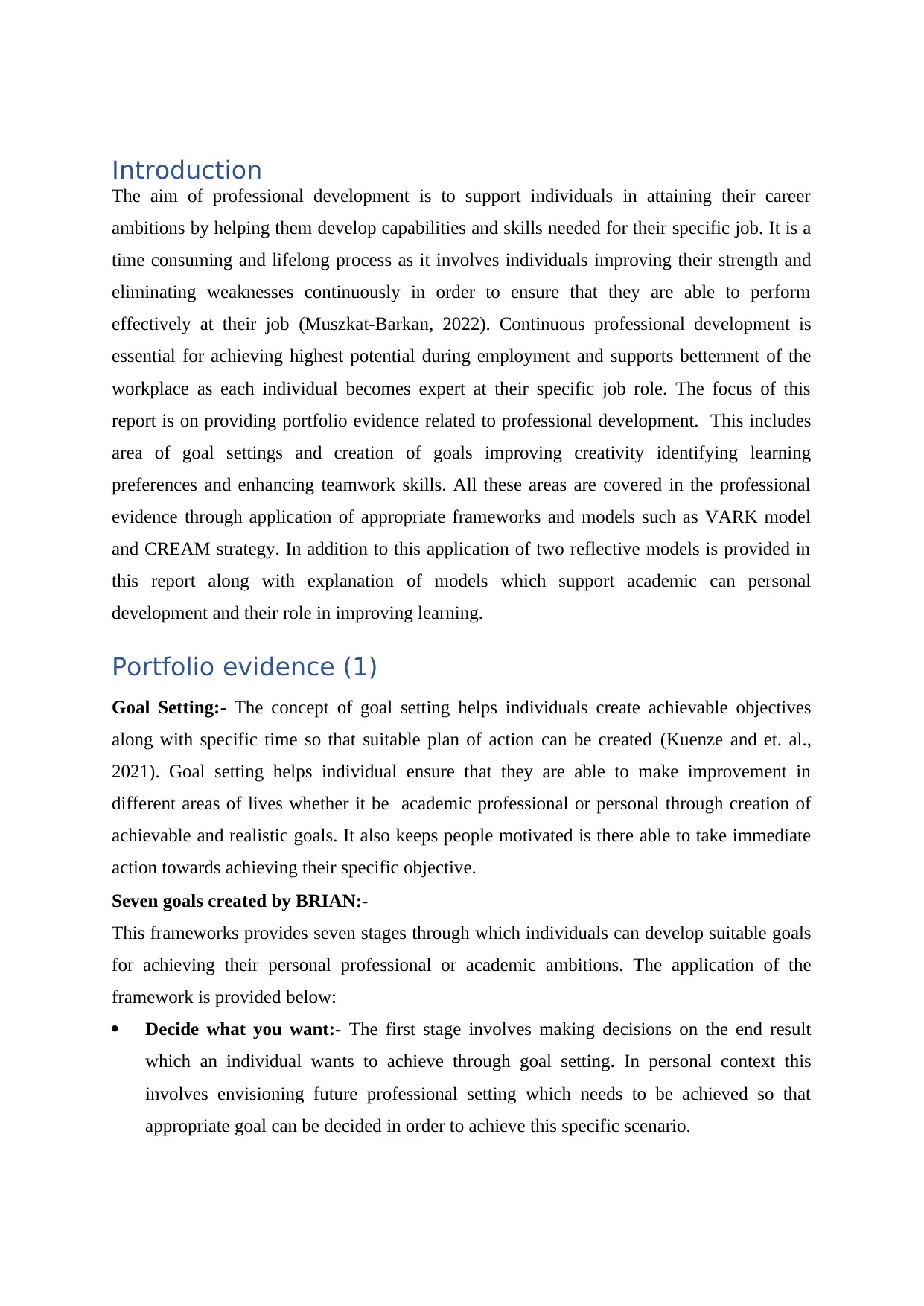
Introduction
The aim of professional development is to support individuals in attaining their career
ambitions by helping them develop capabilities and skills needed for their specific job. It is a
time consuming and lifelong process as it involves individuals improving their strength and
eliminating weaknesses continuously in order to ensure that they are able to perform
effectively at their job (Muszkat-Barkan, 2022). Continuous professional development is
essential for achieving highest potential during employment and supports betterment of the
workplace as each individual becomes expert at their specific job role. The focus of this
report is on providing portfolio evidence related to professional development. This includes
area of goal settings and creation of goals improving creativity identifying learning
preferences and enhancing teamwork skills. All these areas are covered in the professional
evidence through application of appropriate frameworks and models such as VARK model
and CREAM strategy. In addition to this application of two reflective models is provided in
this report along with explanation of models which support academic can personal
development and their role in improving learning.
Portfolio evidence (1)
Goal Setting:- The concept of goal setting helps individuals create achievable objectives
along with specific time so that suitable plan of action can be created (Kuenze and et. al.,
2021). Goal setting helps individual ensure that they are able to make improvement in
different areas of lives whether it be academic professional or personal through creation of
achievable and realistic goals. It also keeps people motivated is there able to take immediate
action towards achieving their specific objective.
Seven goals created by BRIAN:-
This frameworks provides seven stages through which individuals can develop suitable goals
for achieving their personal professional or academic ambitions. The application of the
framework is provided below:
Decide what you want:- The first stage involves making decisions on the end result
which an individual wants to achieve through goal setting. In personal context this
involves envisioning future professional setting which needs to be achieved so that
appropriate goal can be decided in order to achieve this specific scenario.
The aim of professional development is to support individuals in attaining their career
ambitions by helping them develop capabilities and skills needed for their specific job. It is a
time consuming and lifelong process as it involves individuals improving their strength and
eliminating weaknesses continuously in order to ensure that they are able to perform
effectively at their job (Muszkat-Barkan, 2022). Continuous professional development is
essential for achieving highest potential during employment and supports betterment of the
workplace as each individual becomes expert at their specific job role. The focus of this
report is on providing portfolio evidence related to professional development. This includes
area of goal settings and creation of goals improving creativity identifying learning
preferences and enhancing teamwork skills. All these areas are covered in the professional
evidence through application of appropriate frameworks and models such as VARK model
and CREAM strategy. In addition to this application of two reflective models is provided in
this report along with explanation of models which support academic can personal
development and their role in improving learning.
Portfolio evidence (1)
Goal Setting:- The concept of goal setting helps individuals create achievable objectives
along with specific time so that suitable plan of action can be created (Kuenze and et. al.,
2021). Goal setting helps individual ensure that they are able to make improvement in
different areas of lives whether it be academic professional or personal through creation of
achievable and realistic goals. It also keeps people motivated is there able to take immediate
action towards achieving their specific objective.
Seven goals created by BRIAN:-
This frameworks provides seven stages through which individuals can develop suitable goals
for achieving their personal professional or academic ambitions. The application of the
framework is provided below:
Decide what you want:- The first stage involves making decisions on the end result
which an individual wants to achieve through goal setting. In personal context this
involves envisioning future professional setting which needs to be achieved so that
appropriate goal can be decided in order to achieve this specific scenario.
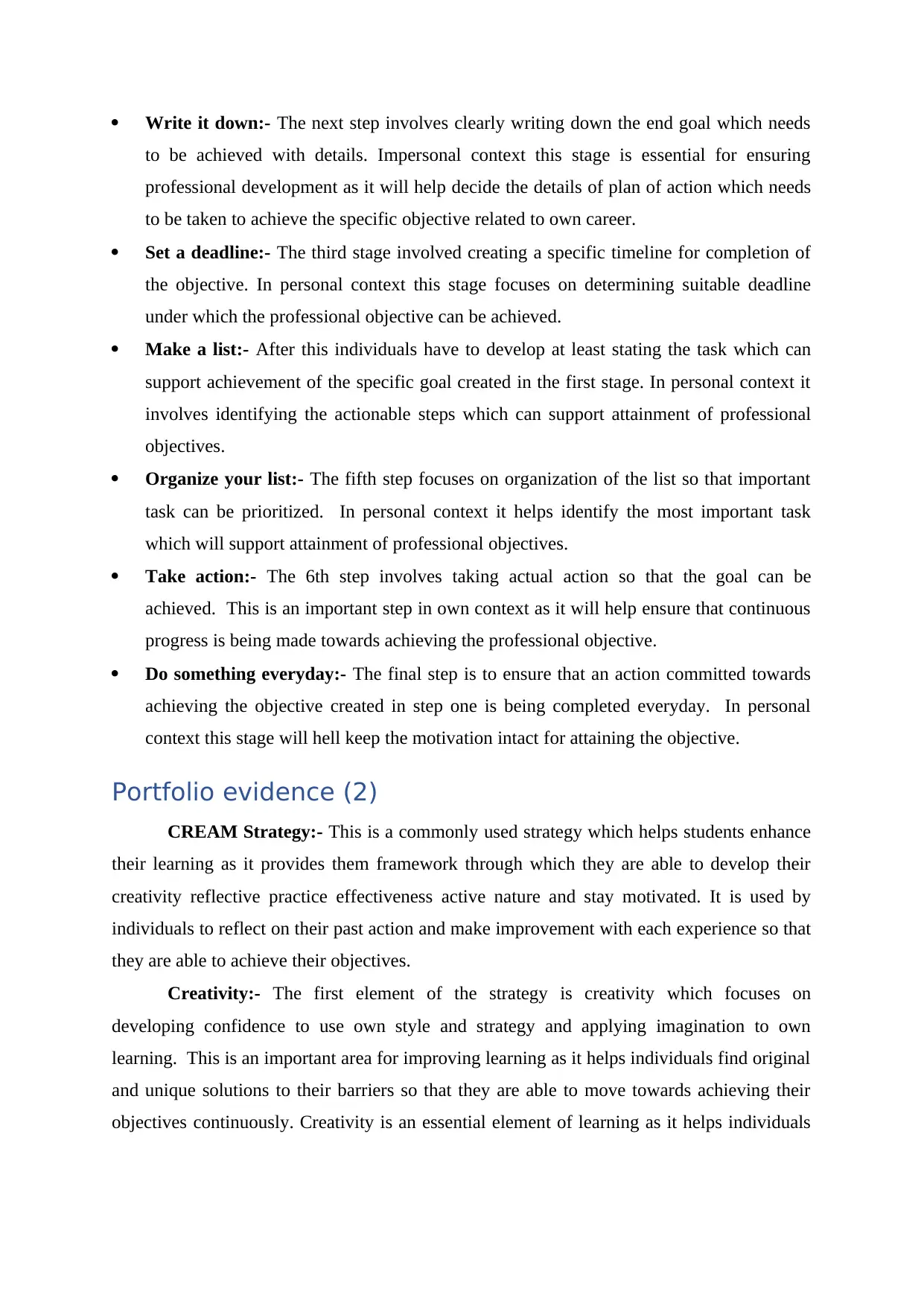
Write it down:- The next step involves clearly writing down the end goal which needs
to be achieved with details. Impersonal context this stage is essential for ensuring
professional development as it will help decide the details of plan of action which needs
to be taken to achieve the specific objective related to own career.
Set a deadline:- The third stage involved creating a specific timeline for completion of
the objective. In personal context this stage focuses on determining suitable deadline
under which the professional objective can be achieved.
Make a list:- After this individuals have to develop at least stating the task which can
support achievement of the specific goal created in the first stage. In personal context it
involves identifying the actionable steps which can support attainment of professional
objectives.
Organize your list:- The fifth step focuses on organization of the list so that important
task can be prioritized. In personal context it helps identify the most important task
which will support attainment of professional objectives.
Take action:- The 6th step involves taking actual action so that the goal can be
achieved. This is an important step in own context as it will help ensure that continuous
progress is being made towards achieving the professional objective.
Do something everyday:- The final step is to ensure that an action committed towards
achieving the objective created in step one is being completed everyday. In personal
context this stage will hell keep the motivation intact for attaining the objective.
Portfolio evidence (2)
CREAM Strategy:- This is a commonly used strategy which helps students enhance
their learning as it provides them framework through which they are able to develop their
creativity reflective practice effectiveness active nature and stay motivated. It is used by
individuals to reflect on their past action and make improvement with each experience so that
they are able to achieve their objectives.
Creativity:- The first element of the strategy is creativity which focuses on
developing confidence to use own style and strategy and applying imagination to own
learning. This is an important area for improving learning as it helps individuals find original
and unique solutions to their barriers so that they are able to move towards achieving their
objectives continuously. Creativity is an essential element of learning as it helps individuals
to be achieved with details. Impersonal context this stage is essential for ensuring
professional development as it will help decide the details of plan of action which needs
to be taken to achieve the specific objective related to own career.
Set a deadline:- The third stage involved creating a specific timeline for completion of
the objective. In personal context this stage focuses on determining suitable deadline
under which the professional objective can be achieved.
Make a list:- After this individuals have to develop at least stating the task which can
support achievement of the specific goal created in the first stage. In personal context it
involves identifying the actionable steps which can support attainment of professional
objectives.
Organize your list:- The fifth step focuses on organization of the list so that important
task can be prioritized. In personal context it helps identify the most important task
which will support attainment of professional objectives.
Take action:- The 6th step involves taking actual action so that the goal can be
achieved. This is an important step in own context as it will help ensure that continuous
progress is being made towards achieving the professional objective.
Do something everyday:- The final step is to ensure that an action committed towards
achieving the objective created in step one is being completed everyday. In personal
context this stage will hell keep the motivation intact for attaining the objective.
Portfolio evidence (2)
CREAM Strategy:- This is a commonly used strategy which helps students enhance
their learning as it provides them framework through which they are able to develop their
creativity reflective practice effectiveness active nature and stay motivated. It is used by
individuals to reflect on their past action and make improvement with each experience so that
they are able to achieve their objectives.
Creativity:- The first element of the strategy is creativity which focuses on
developing confidence to use own style and strategy and applying imagination to own
learning. This is an important area for improving learning as it helps individuals find original
and unique solutions to their barriers so that they are able to move towards achieving their
objectives continuously. Creativity is an essential element of learning as it helps individuals
Secure Best Marks with AI Grader
Need help grading? Try our AI Grader for instant feedback on your assignments.
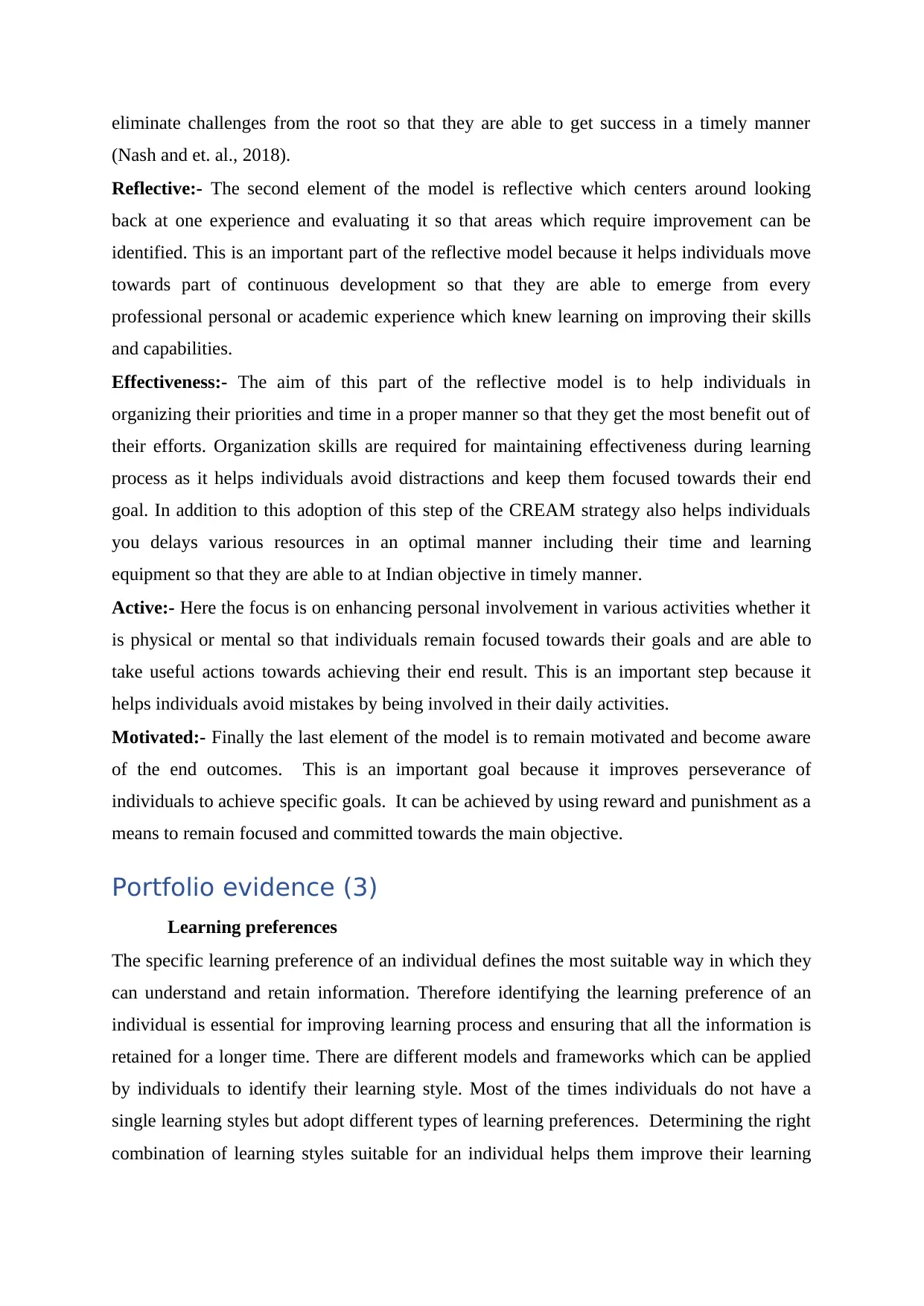
eliminate challenges from the root so that they are able to get success in a timely manner
(Nash and et. al., 2018).
Reflective:- The second element of the model is reflective which centers around looking
back at one experience and evaluating it so that areas which require improvement can be
identified. This is an important part of the reflective model because it helps individuals move
towards part of continuous development so that they are able to emerge from every
professional personal or academic experience which knew learning on improving their skills
and capabilities.
Effectiveness:- The aim of this part of the reflective model is to help individuals in
organizing their priorities and time in a proper manner so that they get the most benefit out of
their efforts. Organization skills are required for maintaining effectiveness during learning
process as it helps individuals avoid distractions and keep them focused towards their end
goal. In addition to this adoption of this step of the CREAM strategy also helps individuals
you delays various resources in an optimal manner including their time and learning
equipment so that they are able to at Indian objective in timely manner.
Active:- Here the focus is on enhancing personal involvement in various activities whether it
is physical or mental so that individuals remain focused towards their goals and are able to
take useful actions towards achieving their end result. This is an important step because it
helps individuals avoid mistakes by being involved in their daily activities.
Motivated:- Finally the last element of the model is to remain motivated and become aware
of the end outcomes. This is an important goal because it improves perseverance of
individuals to achieve specific goals. It can be achieved by using reward and punishment as a
means to remain focused and committed towards the main objective.
Portfolio evidence (3)
Learning preferences
The specific learning preference of an individual defines the most suitable way in which they
can understand and retain information. Therefore identifying the learning preference of an
individual is essential for improving learning process and ensuring that all the information is
retained for a longer time. There are different models and frameworks which can be applied
by individuals to identify their learning style. Most of the times individuals do not have a
single learning styles but adopt different types of learning preferences. Determining the right
combination of learning styles suitable for an individual helps them improve their learning
(Nash and et. al., 2018).
Reflective:- The second element of the model is reflective which centers around looking
back at one experience and evaluating it so that areas which require improvement can be
identified. This is an important part of the reflective model because it helps individuals move
towards part of continuous development so that they are able to emerge from every
professional personal or academic experience which knew learning on improving their skills
and capabilities.
Effectiveness:- The aim of this part of the reflective model is to help individuals in
organizing their priorities and time in a proper manner so that they get the most benefit out of
their efforts. Organization skills are required for maintaining effectiveness during learning
process as it helps individuals avoid distractions and keep them focused towards their end
goal. In addition to this adoption of this step of the CREAM strategy also helps individuals
you delays various resources in an optimal manner including their time and learning
equipment so that they are able to at Indian objective in timely manner.
Active:- Here the focus is on enhancing personal involvement in various activities whether it
is physical or mental so that individuals remain focused towards their goals and are able to
take useful actions towards achieving their end result. This is an important step because it
helps individuals avoid mistakes by being involved in their daily activities.
Motivated:- Finally the last element of the model is to remain motivated and become aware
of the end outcomes. This is an important goal because it improves perseverance of
individuals to achieve specific goals. It can be achieved by using reward and punishment as a
means to remain focused and committed towards the main objective.
Portfolio evidence (3)
Learning preferences
The specific learning preference of an individual defines the most suitable way in which they
can understand and retain information. Therefore identifying the learning preference of an
individual is essential for improving learning process and ensuring that all the information is
retained for a longer time. There are different models and frameworks which can be applied
by individuals to identify their learning style. Most of the times individuals do not have a
single learning styles but adopt different types of learning preferences. Determining the right
combination of learning styles suitable for an individual helps them improve their learning
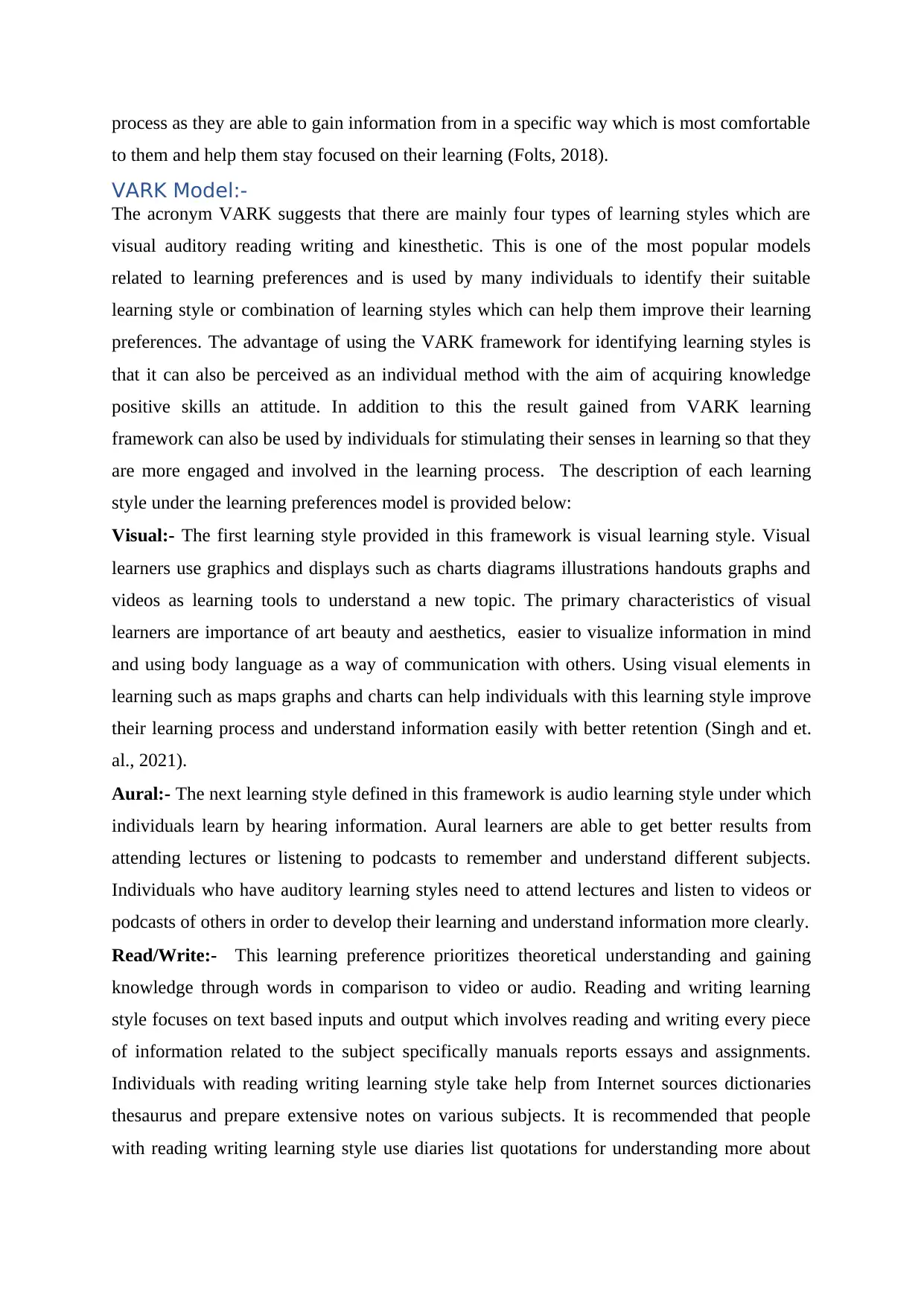
process as they are able to gain information from in a specific way which is most comfortable
to them and help them stay focused on their learning (Folts, 2018).
VARK Model:-
The acronym VARK suggests that there are mainly four types of learning styles which are
visual auditory reading writing and kinesthetic. This is one of the most popular models
related to learning preferences and is used by many individuals to identify their suitable
learning style or combination of learning styles which can help them improve their learning
preferences. The advantage of using the VARK framework for identifying learning styles is
that it can also be perceived as an individual method with the aim of acquiring knowledge
positive skills an attitude. In addition to this the result gained from VARK learning
framework can also be used by individuals for stimulating their senses in learning so that they
are more engaged and involved in the learning process. The description of each learning
style under the learning preferences model is provided below:
Visual:- The first learning style provided in this framework is visual learning style. Visual
learners use graphics and displays such as charts diagrams illustrations handouts graphs and
videos as learning tools to understand a new topic. The primary characteristics of visual
learners are importance of art beauty and aesthetics, easier to visualize information in mind
and using body language as a way of communication with others. Using visual elements in
learning such as maps graphs and charts can help individuals with this learning style improve
their learning process and understand information easily with better retention (Singh and et.
al., 2021).
Aural:- The next learning style defined in this framework is audio learning style under which
individuals learn by hearing information. Aural learners are able to get better results from
attending lectures or listening to podcasts to remember and understand different subjects.
Individuals who have auditory learning styles need to attend lectures and listen to videos or
podcasts of others in order to develop their learning and understand information more clearly.
Read/Write:- This learning preference prioritizes theoretical understanding and gaining
knowledge through words in comparison to video or audio. Reading and writing learning
style focuses on text based inputs and output which involves reading and writing every piece
of information related to the subject specifically manuals reports essays and assignments.
Individuals with reading writing learning style take help from Internet sources dictionaries
thesaurus and prepare extensive notes on various subjects. It is recommended that people
with reading writing learning style use diaries list quotations for understanding more about
to them and help them stay focused on their learning (Folts, 2018).
VARK Model:-
The acronym VARK suggests that there are mainly four types of learning styles which are
visual auditory reading writing and kinesthetic. This is one of the most popular models
related to learning preferences and is used by many individuals to identify their suitable
learning style or combination of learning styles which can help them improve their learning
preferences. The advantage of using the VARK framework for identifying learning styles is
that it can also be perceived as an individual method with the aim of acquiring knowledge
positive skills an attitude. In addition to this the result gained from VARK learning
framework can also be used by individuals for stimulating their senses in learning so that they
are more engaged and involved in the learning process. The description of each learning
style under the learning preferences model is provided below:
Visual:- The first learning style provided in this framework is visual learning style. Visual
learners use graphics and displays such as charts diagrams illustrations handouts graphs and
videos as learning tools to understand a new topic. The primary characteristics of visual
learners are importance of art beauty and aesthetics, easier to visualize information in mind
and using body language as a way of communication with others. Using visual elements in
learning such as maps graphs and charts can help individuals with this learning style improve
their learning process and understand information easily with better retention (Singh and et.
al., 2021).
Aural:- The next learning style defined in this framework is audio learning style under which
individuals learn by hearing information. Aural learners are able to get better results from
attending lectures or listening to podcasts to remember and understand different subjects.
Individuals who have auditory learning styles need to attend lectures and listen to videos or
podcasts of others in order to develop their learning and understand information more clearly.
Read/Write:- This learning preference prioritizes theoretical understanding and gaining
knowledge through words in comparison to video or audio. Reading and writing learning
style focuses on text based inputs and output which involves reading and writing every piece
of information related to the subject specifically manuals reports essays and assignments.
Individuals with reading writing learning style take help from Internet sources dictionaries
thesaurus and prepare extensive notes on various subjects. It is recommended that people
with reading writing learning style use diaries list quotations for understanding more about
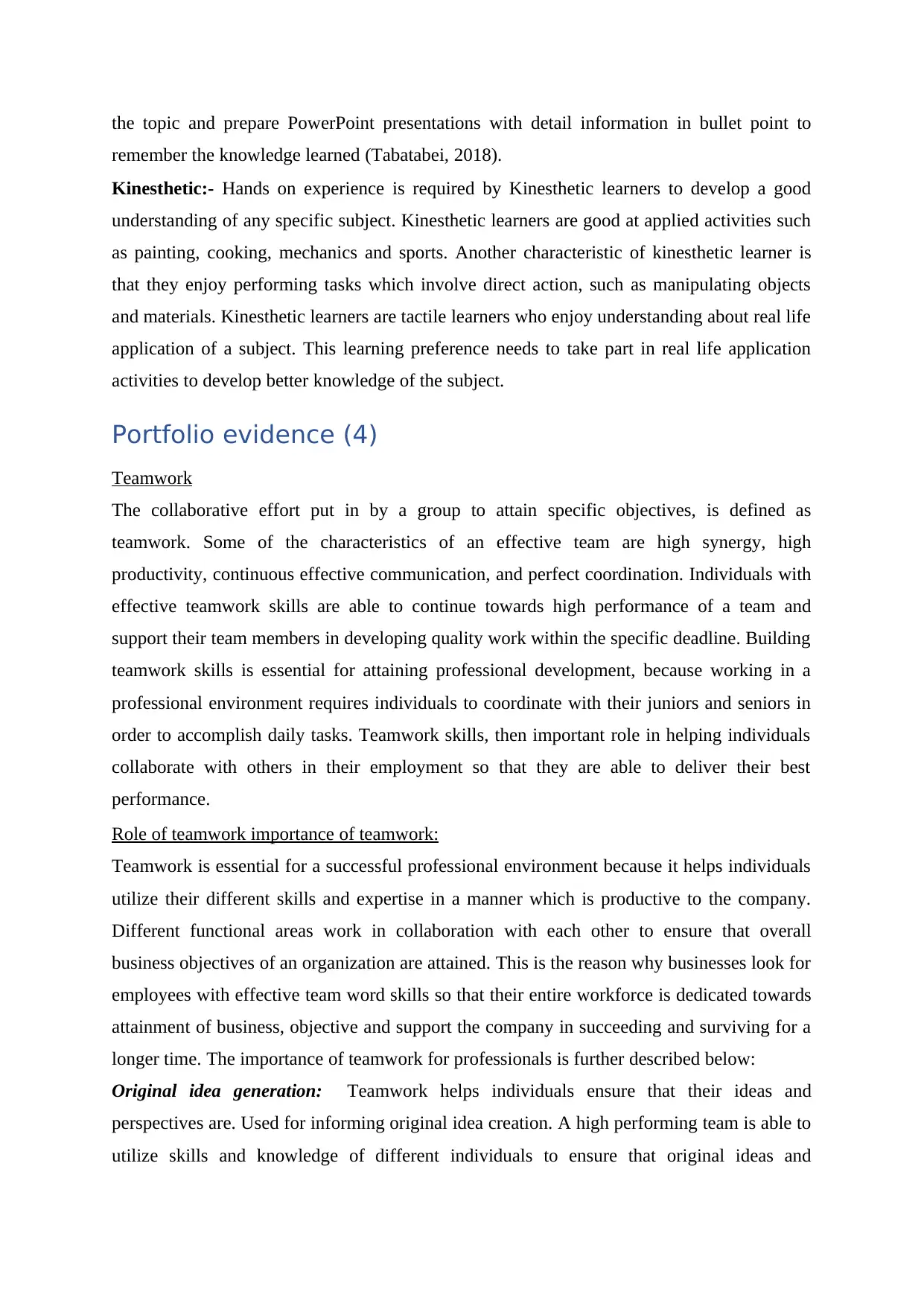
the topic and prepare PowerPoint presentations with detail information in bullet point to
remember the knowledge learned (Tabatabei, 2018).
Kinesthetic:- Hands on experience is required by Kinesthetic learners to develop a good
understanding of any specific subject. Kinesthetic learners are good at applied activities such
as painting, cooking, mechanics and sports. Another characteristic of kinesthetic learner is
that they enjoy performing tasks which involve direct action, such as manipulating objects
and materials. Kinesthetic learners are tactile learners who enjoy understanding about real life
application of a subject. This learning preference needs to take part in real life application
activities to develop better knowledge of the subject.
Portfolio evidence (4)
Teamwork
The collaborative effort put in by a group to attain specific objectives, is defined as
teamwork. Some of the characteristics of an effective team are high synergy, high
productivity, continuous effective communication, and perfect coordination. Individuals with
effective teamwork skills are able to continue towards high performance of a team and
support their team members in developing quality work within the specific deadline. Building
teamwork skills is essential for attaining professional development, because working in a
professional environment requires individuals to coordinate with their juniors and seniors in
order to accomplish daily tasks. Teamwork skills, then important role in helping individuals
collaborate with others in their employment so that they are able to deliver their best
performance.
Role of teamwork importance of teamwork:
Teamwork is essential for a successful professional environment because it helps individuals
utilize their different skills and expertise in a manner which is productive to the company.
Different functional areas work in collaboration with each other to ensure that overall
business objectives of an organization are attained. This is the reason why businesses look for
employees with effective team word skills so that their entire workforce is dedicated towards
attainment of business, objective and support the company in succeeding and surviving for a
longer time. The importance of teamwork for professionals is further described below:
Original idea generation: Teamwork helps individuals ensure that their ideas and
perspectives are. Used for informing original idea creation. A high performing team is able to
utilize skills and knowledge of different individuals to ensure that original ideas and
remember the knowledge learned (Tabatabei, 2018).
Kinesthetic:- Hands on experience is required by Kinesthetic learners to develop a good
understanding of any specific subject. Kinesthetic learners are good at applied activities such
as painting, cooking, mechanics and sports. Another characteristic of kinesthetic learner is
that they enjoy performing tasks which involve direct action, such as manipulating objects
and materials. Kinesthetic learners are tactile learners who enjoy understanding about real life
application of a subject. This learning preference needs to take part in real life application
activities to develop better knowledge of the subject.
Portfolio evidence (4)
Teamwork
The collaborative effort put in by a group to attain specific objectives, is defined as
teamwork. Some of the characteristics of an effective team are high synergy, high
productivity, continuous effective communication, and perfect coordination. Individuals with
effective teamwork skills are able to continue towards high performance of a team and
support their team members in developing quality work within the specific deadline. Building
teamwork skills is essential for attaining professional development, because working in a
professional environment requires individuals to coordinate with their juniors and seniors in
order to accomplish daily tasks. Teamwork skills, then important role in helping individuals
collaborate with others in their employment so that they are able to deliver their best
performance.
Role of teamwork importance of teamwork:
Teamwork is essential for a successful professional environment because it helps individuals
utilize their different skills and expertise in a manner which is productive to the company.
Different functional areas work in collaboration with each other to ensure that overall
business objectives of an organization are attained. This is the reason why businesses look for
employees with effective team word skills so that their entire workforce is dedicated towards
attainment of business, objective and support the company in succeeding and surviving for a
longer time. The importance of teamwork for professionals is further described below:
Original idea generation: Teamwork helps individuals ensure that their ideas and
perspectives are. Used for informing original idea creation. A high performing team is able to
utilize skills and knowledge of different individuals to ensure that original ideas and
Paraphrase This Document
Need a fresh take? Get an instant paraphrase of this document with our AI Paraphraser
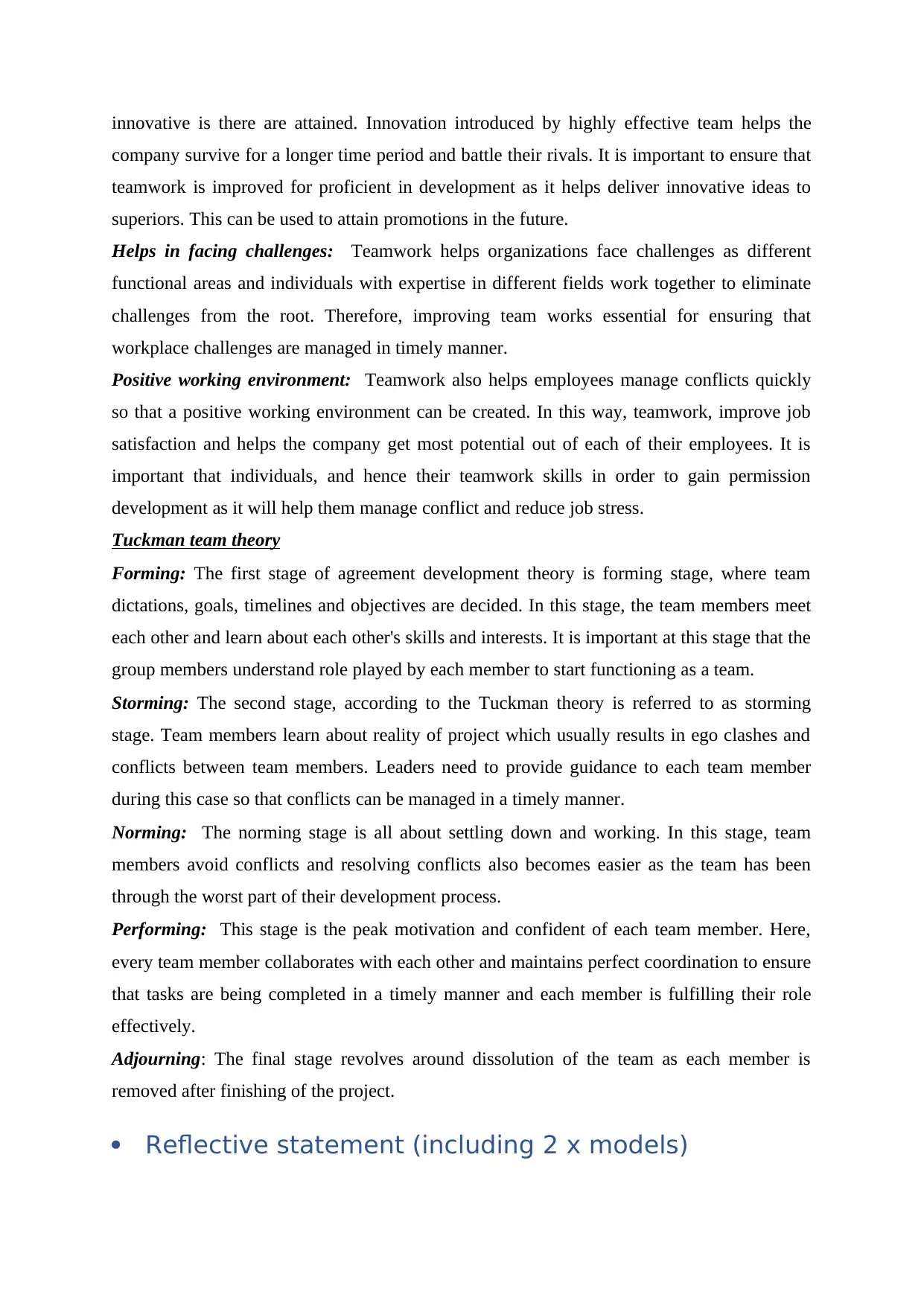
innovative is there are attained. Innovation introduced by highly effective team helps the
company survive for a longer time period and battle their rivals. It is important to ensure that
teamwork is improved for proficient in development as it helps deliver innovative ideas to
superiors. This can be used to attain promotions in the future.
Helps in facing challenges: Teamwork helps organizations face challenges as different
functional areas and individuals with expertise in different fields work together to eliminate
challenges from the root. Therefore, improving team works essential for ensuring that
workplace challenges are managed in timely manner.
Positive working environment: Teamwork also helps employees manage conflicts quickly
so that a positive working environment can be created. In this way, teamwork, improve job
satisfaction and helps the company get most potential out of each of their employees. It is
important that individuals, and hence their teamwork skills in order to gain permission
development as it will help them manage conflict and reduce job stress.
Tuckman team theory
Forming: The first stage of agreement development theory is forming stage, where team
dictations, goals, timelines and objectives are decided. In this stage, the team members meet
each other and learn about each other's skills and interests. It is important at this stage that the
group members understand role played by each member to start functioning as a team.
Storming: The second stage, according to the Tuckman theory is referred to as storming
stage. Team members learn about reality of project which usually results in ego clashes and
conflicts between team members. Leaders need to provide guidance to each team member
during this case so that conflicts can be managed in a timely manner.
Norming: The norming stage is all about settling down and working. In this stage, team
members avoid conflicts and resolving conflicts also becomes easier as the team has been
through the worst part of their development process.
Performing: This stage is the peak motivation and confident of each team member. Here,
every team member collaborates with each other and maintains perfect coordination to ensure
that tasks are being completed in a timely manner and each member is fulfilling their role
effectively.
Adjourning: The final stage revolves around dissolution of the team as each member is
removed after finishing of the project.
Reflective statement (including 2 x models)
company survive for a longer time period and battle their rivals. It is important to ensure that
teamwork is improved for proficient in development as it helps deliver innovative ideas to
superiors. This can be used to attain promotions in the future.
Helps in facing challenges: Teamwork helps organizations face challenges as different
functional areas and individuals with expertise in different fields work together to eliminate
challenges from the root. Therefore, improving team works essential for ensuring that
workplace challenges are managed in timely manner.
Positive working environment: Teamwork also helps employees manage conflicts quickly
so that a positive working environment can be created. In this way, teamwork, improve job
satisfaction and helps the company get most potential out of each of their employees. It is
important that individuals, and hence their teamwork skills in order to gain permission
development as it will help them manage conflict and reduce job stress.
Tuckman team theory
Forming: The first stage of agreement development theory is forming stage, where team
dictations, goals, timelines and objectives are decided. In this stage, the team members meet
each other and learn about each other's skills and interests. It is important at this stage that the
group members understand role played by each member to start functioning as a team.
Storming: The second stage, according to the Tuckman theory is referred to as storming
stage. Team members learn about reality of project which usually results in ego clashes and
conflicts between team members. Leaders need to provide guidance to each team member
during this case so that conflicts can be managed in a timely manner.
Norming: The norming stage is all about settling down and working. In this stage, team
members avoid conflicts and resolving conflicts also becomes easier as the team has been
through the worst part of their development process.
Performing: This stage is the peak motivation and confident of each team member. Here,
every team member collaborates with each other and maintains perfect coordination to ensure
that tasks are being completed in a timely manner and each member is fulfilling their role
effectively.
Adjourning: The final stage revolves around dissolution of the team as each member is
removed after finishing of the project.
Reflective statement (including 2 x models)
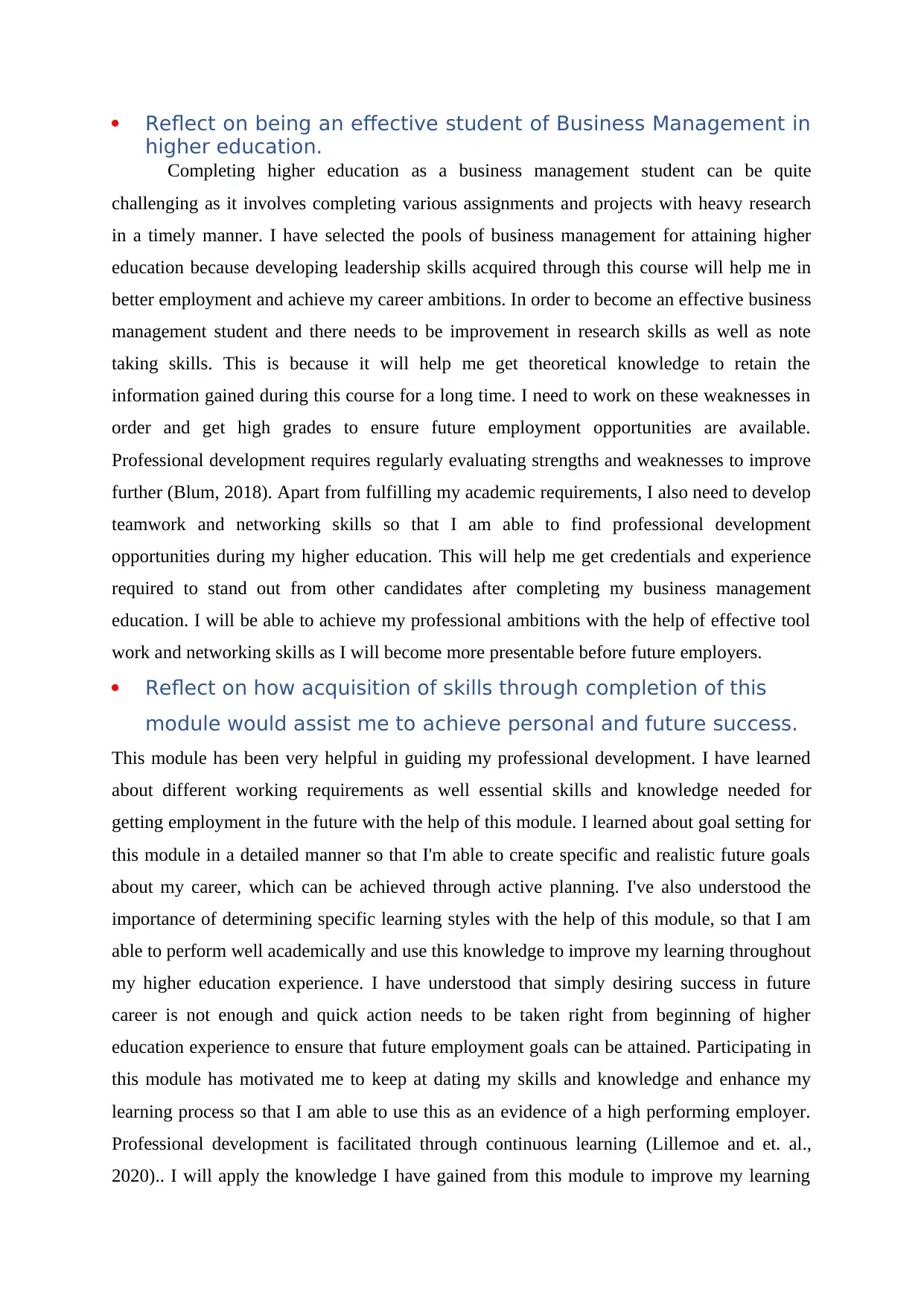
Reflect on being an effective student of Business Management in
higher education.
Completing higher education as a business management student can be quite
challenging as it involves completing various assignments and projects with heavy research
in a timely manner. I have selected the pools of business management for attaining higher
education because developing leadership skills acquired through this course will help me in
better employment and achieve my career ambitions. In order to become an effective business
management student and there needs to be improvement in research skills as well as note
taking skills. This is because it will help me get theoretical knowledge to retain the
information gained during this course for a long time. I need to work on these weaknesses in
order and get high grades to ensure future employment opportunities are available.
Professional development requires regularly evaluating strengths and weaknesses to improve
further (Blum, 2018). Apart from fulfilling my academic requirements, I also need to develop
teamwork and networking skills so that I am able to find professional development
opportunities during my higher education. This will help me get credentials and experience
required to stand out from other candidates after completing my business management
education. I will be able to achieve my professional ambitions with the help of effective tool
work and networking skills as I will become more presentable before future employers.
Reflect on how acquisition of skills through completion of this
module would assist me to achieve personal and future success.
This module has been very helpful in guiding my professional development. I have learned
about different working requirements as well essential skills and knowledge needed for
getting employment in the future with the help of this module. I learned about goal setting for
this module in a detailed manner so that I'm able to create specific and realistic future goals
about my career, which can be achieved through active planning. I've also understood the
importance of determining specific learning styles with the help of this module, so that I am
able to perform well academically and use this knowledge to improve my learning throughout
my higher education experience. I have understood that simply desiring success in future
career is not enough and quick action needs to be taken right from beginning of higher
education experience to ensure that future employment goals can be attained. Participating in
this module has motivated me to keep at dating my skills and knowledge and enhance my
learning process so that I am able to use this as an evidence of a high performing employer.
Professional development is facilitated through continuous learning (Lillemoe and et. al.,
2020).. I will apply the knowledge I have gained from this module to improve my learning
higher education.
Completing higher education as a business management student can be quite
challenging as it involves completing various assignments and projects with heavy research
in a timely manner. I have selected the pools of business management for attaining higher
education because developing leadership skills acquired through this course will help me in
better employment and achieve my career ambitions. In order to become an effective business
management student and there needs to be improvement in research skills as well as note
taking skills. This is because it will help me get theoretical knowledge to retain the
information gained during this course for a long time. I need to work on these weaknesses in
order and get high grades to ensure future employment opportunities are available.
Professional development requires regularly evaluating strengths and weaknesses to improve
further (Blum, 2018). Apart from fulfilling my academic requirements, I also need to develop
teamwork and networking skills so that I am able to find professional development
opportunities during my higher education. This will help me get credentials and experience
required to stand out from other candidates after completing my business management
education. I will be able to achieve my professional ambitions with the help of effective tool
work and networking skills as I will become more presentable before future employers.
Reflect on how acquisition of skills through completion of this
module would assist me to achieve personal and future success.
This module has been very helpful in guiding my professional development. I have learned
about different working requirements as well essential skills and knowledge needed for
getting employment in the future with the help of this module. I learned about goal setting for
this module in a detailed manner so that I'm able to create specific and realistic future goals
about my career, which can be achieved through active planning. I've also understood the
importance of determining specific learning styles with the help of this module, so that I am
able to perform well academically and use this knowledge to improve my learning throughout
my higher education experience. I have understood that simply desiring success in future
career is not enough and quick action needs to be taken right from beginning of higher
education experience to ensure that future employment goals can be attained. Participating in
this module has motivated me to keep at dating my skills and knowledge and enhance my
learning process so that I am able to use this as an evidence of a high performing employer.
Professional development is facilitated through continuous learning (Lillemoe and et. al.,
2020).. I will apply the knowledge I have gained from this module to improve my learning
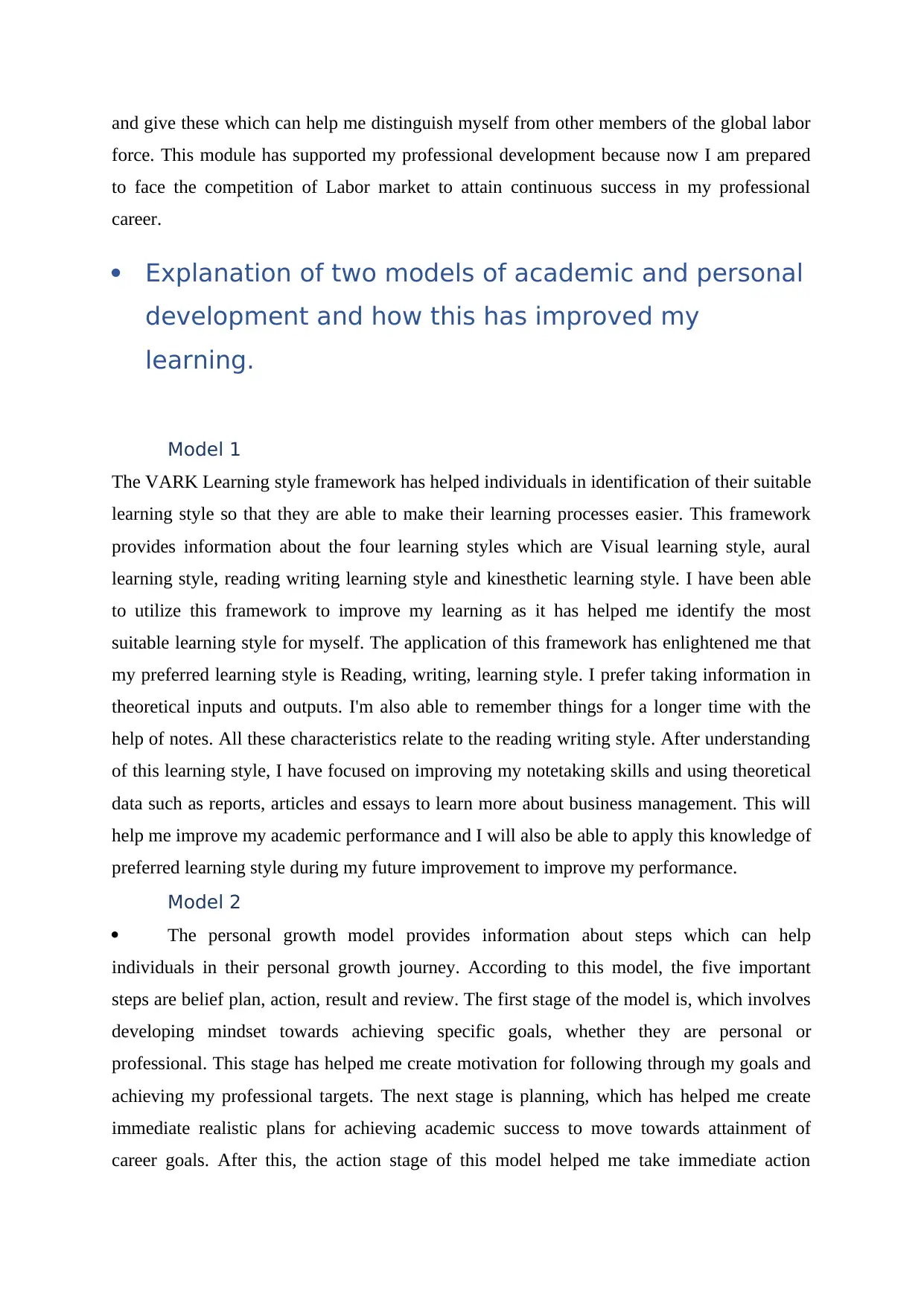
and give these which can help me distinguish myself from other members of the global labor
force. This module has supported my professional development because now I am prepared
to face the competition of Labor market to attain continuous success in my professional
career.
Explanation of two models of academic and personal
development and how this has improved my
learning.
Model 1
The VARK Learning style framework has helped individuals in identification of their suitable
learning style so that they are able to make their learning processes easier. This framework
provides information about the four learning styles which are Visual learning style, aural
learning style, reading writing learning style and kinesthetic learning style. I have been able
to utilize this framework to improve my learning as it has helped me identify the most
suitable learning style for myself. The application of this framework has enlightened me that
my preferred learning style is Reading, writing, learning style. I prefer taking information in
theoretical inputs and outputs. I'm also able to remember things for a longer time with the
help of notes. All these characteristics relate to the reading writing style. After understanding
of this learning style, I have focused on improving my notetaking skills and using theoretical
data such as reports, articles and essays to learn more about business management. This will
help me improve my academic performance and I will also be able to apply this knowledge of
preferred learning style during my future improvement to improve my performance.
Model 2
The personal growth model provides information about steps which can help
individuals in their personal growth journey. According to this model, the five important
steps are belief plan, action, result and review. The first stage of the model is, which involves
developing mindset towards achieving specific goals, whether they are personal or
professional. This stage has helped me create motivation for following through my goals and
achieving my professional targets. The next stage is planning, which has helped me create
immediate realistic plans for achieving academic success to move towards attainment of
career goals. After this, the action stage of this model helped me take immediate action
force. This module has supported my professional development because now I am prepared
to face the competition of Labor market to attain continuous success in my professional
career.
Explanation of two models of academic and personal
development and how this has improved my
learning.
Model 1
The VARK Learning style framework has helped individuals in identification of their suitable
learning style so that they are able to make their learning processes easier. This framework
provides information about the four learning styles which are Visual learning style, aural
learning style, reading writing learning style and kinesthetic learning style. I have been able
to utilize this framework to improve my learning as it has helped me identify the most
suitable learning style for myself. The application of this framework has enlightened me that
my preferred learning style is Reading, writing, learning style. I prefer taking information in
theoretical inputs and outputs. I'm also able to remember things for a longer time with the
help of notes. All these characteristics relate to the reading writing style. After understanding
of this learning style, I have focused on improving my notetaking skills and using theoretical
data such as reports, articles and essays to learn more about business management. This will
help me improve my academic performance and I will also be able to apply this knowledge of
preferred learning style during my future improvement to improve my performance.
Model 2
The personal growth model provides information about steps which can help
individuals in their personal growth journey. According to this model, the five important
steps are belief plan, action, result and review. The first stage of the model is, which involves
developing mindset towards achieving specific goals, whether they are personal or
professional. This stage has helped me create motivation for following through my goals and
achieving my professional targets. The next stage is planning, which has helped me create
immediate realistic plans for achieving academic success to move towards attainment of
career goals. After this, the action stage of this model helped me take immediate action
Secure Best Marks with AI Grader
Need help grading? Try our AI Grader for instant feedback on your assignments.
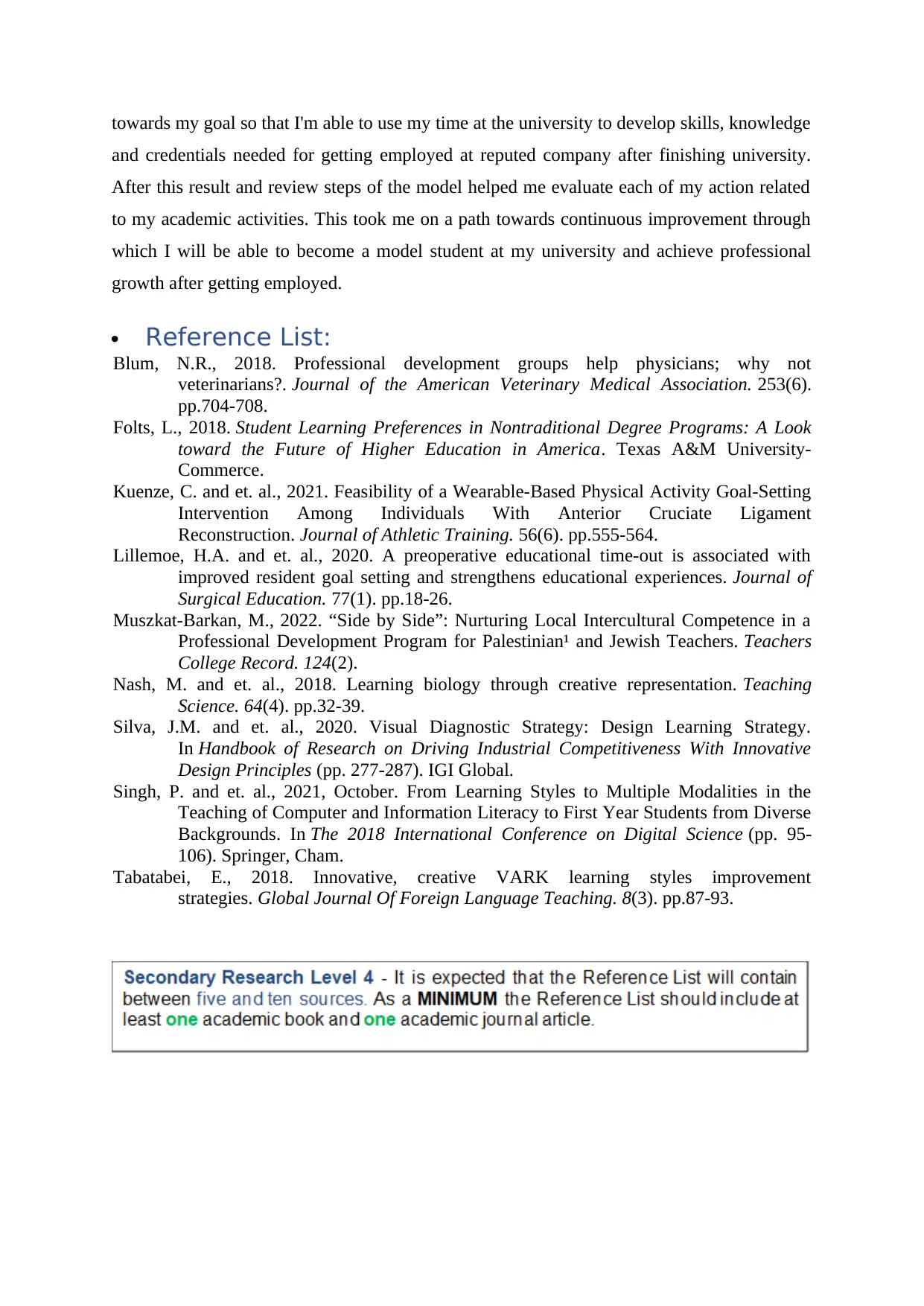
towards my goal so that I'm able to use my time at the university to develop skills, knowledge
and credentials needed for getting employed at reputed company after finishing university.
After this result and review steps of the model helped me evaluate each of my action related
to my academic activities. This took me on a path towards continuous improvement through
which I will be able to become a model student at my university and achieve professional
growth after getting employed.
Reference List:
Blum, N.R., 2018. Professional development groups help physicians; why not
veterinarians?. Journal of the American Veterinary Medical Association. 253(6).
pp.704-708.
Folts, L., 2018. Student Learning Preferences in Nontraditional Degree Programs: A Look
toward the Future of Higher Education in America. Texas A&M University-
Commerce.
Kuenze, C. and et. al., 2021. Feasibility of a Wearable-Based Physical Activity Goal-Setting
Intervention Among Individuals With Anterior Cruciate Ligament
Reconstruction. Journal of Athletic Training. 56(6). pp.555-564.
Lillemoe, H.A. and et. al., 2020. A preoperative educational time-out is associated with
improved resident goal setting and strengthens educational experiences. Journal of
Surgical Education. 77(1). pp.18-26.
Muszkat-Barkan, M., 2022. “Side by Side”: Nurturing Local Intercultural Competence in a
Professional Development Program for Palestinian¹ and Jewish Teachers. Teachers
College Record. 124(2).
Nash, M. and et. al., 2018. Learning biology through creative representation. Teaching
Science. 64(4). pp.32-39.
Silva, J.M. and et. al., 2020. Visual Diagnostic Strategy: Design Learning Strategy.
In Handbook of Research on Driving Industrial Competitiveness With Innovative
Design Principles (pp. 277-287). IGI Global.
Singh, P. and et. al., 2021, October. From Learning Styles to Multiple Modalities in the
Teaching of Computer and Information Literacy to First Year Students from Diverse
Backgrounds. In The 2018 International Conference on Digital Science (pp. 95-
106). Springer, Cham.
Tabatabei, E., 2018. Innovative, creative VARK learning styles improvement
strategies. Global Journal Of Foreign Language Teaching. 8(3). pp.87-93.
and credentials needed for getting employed at reputed company after finishing university.
After this result and review steps of the model helped me evaluate each of my action related
to my academic activities. This took me on a path towards continuous improvement through
which I will be able to become a model student at my university and achieve professional
growth after getting employed.
Reference List:
Blum, N.R., 2018. Professional development groups help physicians; why not
veterinarians?. Journal of the American Veterinary Medical Association. 253(6).
pp.704-708.
Folts, L., 2018. Student Learning Preferences in Nontraditional Degree Programs: A Look
toward the Future of Higher Education in America. Texas A&M University-
Commerce.
Kuenze, C. and et. al., 2021. Feasibility of a Wearable-Based Physical Activity Goal-Setting
Intervention Among Individuals With Anterior Cruciate Ligament
Reconstruction. Journal of Athletic Training. 56(6). pp.555-564.
Lillemoe, H.A. and et. al., 2020. A preoperative educational time-out is associated with
improved resident goal setting and strengthens educational experiences. Journal of
Surgical Education. 77(1). pp.18-26.
Muszkat-Barkan, M., 2022. “Side by Side”: Nurturing Local Intercultural Competence in a
Professional Development Program for Palestinian¹ and Jewish Teachers. Teachers
College Record. 124(2).
Nash, M. and et. al., 2018. Learning biology through creative representation. Teaching
Science. 64(4). pp.32-39.
Silva, J.M. and et. al., 2020. Visual Diagnostic Strategy: Design Learning Strategy.
In Handbook of Research on Driving Industrial Competitiveness With Innovative
Design Principles (pp. 277-287). IGI Global.
Singh, P. and et. al., 2021, October. From Learning Styles to Multiple Modalities in the
Teaching of Computer and Information Literacy to First Year Students from Diverse
Backgrounds. In The 2018 International Conference on Digital Science (pp. 95-
106). Springer, Cham.
Tabatabei, E., 2018. Innovative, creative VARK learning styles improvement
strategies. Global Journal Of Foreign Language Teaching. 8(3). pp.87-93.
1 out of 11
Related Documents
Your All-in-One AI-Powered Toolkit for Academic Success.
+13062052269
info@desklib.com
Available 24*7 on WhatsApp / Email
![[object Object]](/_next/static/media/star-bottom.7253800d.svg)
Unlock your academic potential
© 2024 | Zucol Services PVT LTD | All rights reserved.



